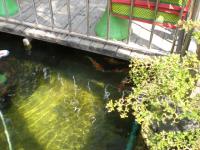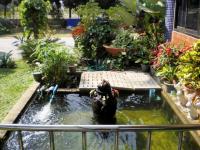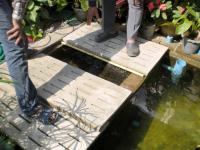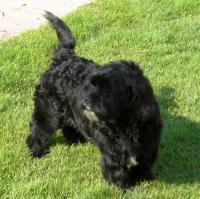
drtreelove
-
Posts
1,933 -
Joined
-
Last visited
Content Type
Events
Forums
Downloads
Quizzes
Gallery
Blogs
Posts posted by drtreelove
-
-
I want to buy the Westernized version of Red Bull in Bangkok. I thought I saw it in Khao San Road but I may be mistaken. The version I am referring to is from the Austria company and comes in a tall thin aluminum can and is carbonated and sold in the U.S., Europe, Australia, etc. I've only been able to find the original Thai version in the glass medicine bottle (Krating Daeng). I also hear that SHARK is a similar energy drink in taste to the Westernized Red Bull version.
If anyone knows where to buy in Thailand, specific Bangkok, please let me know. I have a friend in Ko Samui, Trang, Krabi, Phuket area looking for it as well.
Thanks,
Zen.
Shark in the tall silver cans is similar to Red Bull in effect, but with a milder, less sour taste. I like it better than red bull. I buy it at Esso stations and Jiffy marts at Jet and PTT, some 7-11's now.
-
Round up is available here in the Thai form for a fraction of the price of the monsanto original......called glycolol . Just read the active ingredient on a bottle of round up and/or ask for the Thai round up.
Best to use a spreader-sticker and spray on new weed growth.
The active ingredient in Round Up is 'glyphosate'. I have used the "Thai form", a generic brand with 48% glyphosate, but I don't think it is what is says it is, I have to mix it at least two to four times as strong to get the same results as the Monsanto product; even then it takes repeated applications to get control, even on grasses.
Round up is best for contol of grasses, but will kill broadleaf plants too with repeat applications. Be careful about the 'drift' of the herbacide spray, which can harm plants that you want to keep. Don't spray it on shrubs or trees with green stems that you want to keep.
Don't forget that the hoe and shovel are very effective too and will give you a little exercise while you are controlling weeds. Your sweat won't pollute the groundwater.
-
"its sweet and from our farm its totally organic, Cheers Lickey"
"As things are at the moment the salad beds are still bare due to overuse of cides,"
Excuse me, but is this the same farm?
-
Now has anyone had a similar experience with a successful resolution? And does anyone know of any doctor in Thailand or neighboring countries who specialize in Tinnitus or similar symptoms?
I had developed tinnitus several years ago, and tried many avenues of treatment. It cleared up finally with the help of traditional Chinese medicine. My doctor in Oakland California USA treated me with herbs; no acupuncture. He classifies it as a symptom of weakness in the kidney energy functioning and uses herbs to build that and bladder energy channels. He also advises no alcohol, drugs, or other debilitating consumption or activities; moderate exercise, moderate sexual activity are ok, but excesses will contribute to this condition. Some prescription drugns and over the counter meds like ibuprofen will contribute to weakening of this energy.
If you don't have access to Chinese medical doctor (but there are some good ones in Chiang Mai), try cleaning up your consumption and lifestyle to conserve your basic energy. And make up some bone soup once a week for a month or two: Simmer 1 kilo of pork bones (or chicken or beef) for 4 hours with 1 teaspoon of salt and fresh ginger (8 slices 1 1/2 to 2 inch diameter). Start with 3 or 4 liters of water and boil down to 1 liter. Strain out the bones and ginger and refrigerate the broth overnight. Skim off the solidified fat and use the broth for making soup. I make pork, onion and cabbage soup sometimes with celery, seaweeds or other vegetables, barley or azuki beans and Japanese pumpkin (kabocha, the big green ones). This is a highly nourishing soup that will help build you kidney energy. It is great to build body warmth for winter, but if I had tinnitus I would be making some up right now, even though it is hot season.
Good luck, Don
-
700th Anniversary of Chiang Mai Sports Complex (Sanam Jet Roi Pee)
(Old article from 2003 Some things have changed)
No this is not a 700 year old sports stadium. No red brick ruins, and the only ancient athletic rituals held here are more of the Greek olympic variety. It's a modern sports complex, built in the mid-1990's for the South East Asian Games and named to commemorate the 700th anniversary of the founding of Chiang Mai.
Sanam jet roi pee (for local drivers) is located at the base of Doi Suthep/Doi Pui, on the west side of the irrigation canal road, 4.2 kilometers north of Huay Kaew Road, just east of City Hall. The park is identifiable by the large ornimental gate over the south entrance road, and the large swimming pool stadium visable from t he canal road. There is a second entrance just north of the pool stadium.
This is a multiple stadium sports event complex and community sports and exercise facility, operated by the Sports Authority of Thailand, Region 5, Boonthan Muangchuen, director.
One of the most popular facilities is the swimming pool, by far the best in Chiang Mai for serious lap swimming. It's a 50 meter olympic pool and adjacent diving pool with spring boards and platforms. The pool water is clean and clear and well maintained. The chlorine level is high (as it should be for algae and disease control) but not excessive. The deck is in good condition, but the pool tiles are in disrepair with many loose and missing tiles. I mention this to caution you about sharp edges, I cut my foot once. There are toilets, showers and changing booths. There are suposed to be lockers available for an additional fee. I've never used them or seen an attendant.
[The following may have changed]
The pool is open 9am to 8pm, Tuesday through Sunday. Closed Monday and sometimes unexpectedly for holidays and events. Entrance fee is 40 baht for adult non-members, 20 for members. Children (through high school or 20 years old) are 1/2 the adult fee. Swimming lessons are available.
A couple of notes: This pool is not suitable for small children or non-swimmers. The shallowest part (each end) is over one meter deep. (Chiang Mai Land pool, in the southeast part of town, is more appropriate for young kids and for family fun and relaxation.) Also, serious lap swimmers accustomed to courteous pool etiquette and lane occupancy respect may be disappointed. It's a free-for-all with no designated lanes or times for lap swimmers. During busy hours be ready for cross-pool swimmers and head-on lane traffic. Avoid late afternoons and evenings when it is most crowded, but from opening through mid-day, especially non-holiday week days, there are few people using the pool.
Other facilities in the complex include: a tennis center, with instructor available, pro shop and racket rentals. Court fees are 40 baht per hour per court, for non-members, 1/2 price for members. There is also a shooting range, a main stadium, three indoor stadiums and a velodrome (bicycle racing stadium), an outdoor football field and running track, and outdoor courts for basketball, volleyball, badminton, sepak takraw and aerobic dance. The perimeter road is used by many people, especially in the evenings for a 2 K jogging and cycling track.
There is a 70 room hotel/event dormitory, near the main stadium. The hotel houses a decent inexpensive restaurant open from 7 am (although it has been closed lately, I hope only temporarily). Khun Songpol Muangsri is the hotel manager.
The weight room, called fitness center is located in the hotel. Open 8am to 8pm, there is a use fee of 20 baht/non-members or 10 baht for members. [Now at the swimming pool; 30bt/15bt] This is a spacious, well ventilated room with lots of windows opening to allow a natural airflow off the base of the mountain. I prefer this to air conditioning for my workouts. There is no trainer, attendant or water available (until the restaurant is open). If you use a towel or equipment wipe-down disinfectant, bring your own.
There is a full range of basic weight resistance exercise equipment, but there are some deficiences for the serous fitness buff who is used to modern western gyms. Forget about sustained cardio-vascular exercise here, unless you do your own jumping jacks. The stationary bikes are barely functional and the only treadmill seems to be permanently out of service. You won't find high-end Nautilus or Cybex type machines here, but there is enough selection of resistance for basic muscle groups. It's mostly old Joe Wieder, Universal type machines and a minimal selection of free-weights and benches. You can build your own dumbells and barbells if you want to go heavy. Real big men, serious lifters, may not have enough free-weight here. Like the other facilities in the complex, late afternoons /evenings see the most use. Morning and mid-day you may have the weight room all to yourself.
Up in back of the hotel (outside of the 700 yr complex) you will find a reservoir and trails for hiking, dog walking or mountain biking. Some trails connect with Huay Tung Tao park about 3 K to the north.
The Chiang Mai Sports Complex has membership available for Thais and expats. It's 500 baht per year individual or 1000 for family membership (up to 5 persons). There are also special student and group rates. Apply at the pool entrance desk (Khun Mam speaks some English). You need 2 photos (1" ) and ID. Membership allows you discounted entry to most of the paid activities (not aerobic dance). There doesn't seem to be any other benefits, I've received no mailing or notification of events or closures.
Be advised that the complex sometime hosts auto and motorcycle drag races. It's my pet peeve. The noise and air pollution is horrible, not suitable for healthy exercise. And they block off the perimeter road and some of the outdoor courts unexpectedly, inconveniencing regular facility users. And of course the racers don't always restrict their speeding to the designated track, beware and watch your children.
Other than that it's a great park where you can get some good exercise and possibly meet other health minded people.
-
I would be interested to know if any CM residents have had experience with a tree pruning/removal contractor, not just a machete mutilation crew like kimincm witnessed:
"I watched the 30+ rai of trees over the road from me get their annual heavy pruning last year,just after
fruiting finished, no Arborist,two women,ladder and chain saw,600B/day the whole show."
but climbers and possibly big-tree equipment like aerial lift truck and crane. If so please let me know; we're trying to put together some resources for tree work here. I've been asked to be a Thailand representative for a regional branch of the ISA (International Society of Arboriculture www.isa-arbor.com) Thailand has a long way to go at promoting good tree care. don
-
http://www.commongroundinpaloalto.org/
I know that store; frequent shopper in the mid 70's. I worked at the biodynamic french intensive garden on the Syntex property with John Jeavons for awhile. But mostly I was climbing trees for a living. dc
-
Ive got 8 lovely longan trees in my garden. One or two produce fruit each year. Is there any way to encourage the others to bear fruit.
No innuendos thanks
Deep watering through the dry season is a key element; best is flood irrigation where you are putting on a large enough volume of water to get substantial depth of water saturation into the soil. Do this every ten days. Fertilization and pest control are important considerations.
I managed a 2+rai orchard with 73 trees a few years ago and had some good advisors through the process, so learned a lot. I went all out with irrigation, fertilization including foliar sprays with seaweed micronutrient solutions, green manure crops and diligent pest and disease control. We had bee hives placed for pollination. We got good crops, but it was hardly worth it financially because the market price was so depressed.
Now in a new home, I only have two young lamyai trees. One is loaded with flowers right now, the other is putting out lots of new growth and just starting to show some flower buds. I am watering regularly. I fertilized with 15-15-15 a couple of months ago to bring them out of the depressed condition that existed when I moved in. I now have mulched with 6 inches of rice straw and started building soil organic matter with compost and manure, so I probably won't use chemical fertilizer again. I was spraying about every 10 days with neem oil extract to repel insect pests from chewing on the leaves, but I have stopped now for the flowering process.
If your trees are not flowering now or very soon, there may be stress factors and you won't get a crop this year. But in any case, start now to cultivate good conditions.
You have to decide if you are going for maximum crop production, or just some good lamyai to eat and give to friends. If you want to produce maximum fruit, then you must minimize weeds and grasses within the area under the foliar canopy of the trees to cut down on competition for water and nutrients. You say the trees are in your garden, so maybe you can't avoid having plantings in the tree root zone. In that case, the deep watering is very important. Trees in lawns sometimes are drought stressed because the grasses take the majority of the water and not much gets through to the tree roots. The same applies for nutrients, if you have lawns under the trees you may need extra or subsurface fertilization.
Honey bees are important pollinators, so don't let anyone talk you into spraying pestcides throughout the flowering process. To maximize pollination, bring in a bee hive from a commercial honey producer. If your trees are already flowering, it may be too late to arrange for this year.
Some commercial growers head back the tree branch structure very severely after the fruit is picked, to promote thick new growth. I don't advise this; it's ugly and I think that proper thinning and light shaping is enough to stimulate growth and still have a beautiful tree and not a large hat rack.
There are probably more lamyai farmers on the TV Farming in Thailand forum, they may be able to give you more or better info than I can. But thanks for the opportunity to recall my many happy hard working days in the orchard. don
-
The question still remains... anyone know of an "arborist" or tree doctor here locally in CM?
I know a tree guy. But he still has a lot to learn; so don't blame me if he can't answer all your questions. But if he doesn't know first hand, he usually can find out. PM me or ask it on the Farming inThailand or Plants Pets and Vets forums, I'm more regular there. Don
-
Hello drtreelove, so what would the cost of this happy horseshit spread over 1rai cost? Would it be cost effective now in a time of low rubber prices and would it be sub-stainable enough in the long turn?
Is man ready for 'organic rubber'?
rice555
Rice You're right, maybe not practical. I just threw that out as general information and another perspective for this thread on soil testing.
But happy horseshit isn't the only way to go (I like that term though). I don't know much about rubber, but in other farming situations, green manuring is a relatively inexpensive way to get organic matter to the soil, especially since you can get free seeds from the land development department. In fruit orchards I mow and leave lay as mulch, so there is no tractor work needed. If I seed during rainy season so I don't have to irrigate, cut the cover crop myself and don't hire labor, there is almost zero cost except for a little gasoline to go get the seeds and for my 'krueng tat ya'. Now that's cheap organic matter don't you think? don
-
Thanks, I have two reasons for the soil tests. One is to assess the Ph level and adjust it as necessary so the rubber trees can get the maximum nutrient uptake from the soil. I understand that Ph level has a lot to do with this, am still researching to find the optimum Ph level for my soil as regards rubber trees nutrition.
http://forum.agriculture.ph/viewtopic.php?f=82&t=186
Consider this statement regarding “expensive soil tests”, from the excellent book Permaculture Home Garden by Linda Woodrow (Viking Penguin Books, Australia):
“Ironically, however, the question is mostly academic. The cure for heavy clay soil is to add organic matter to breakup the clay and improve drainage. The cure for sandy, dry soil is to add organic matter to retain water. The cure for acid soil is to add organic matter, particularly bird manure, to bring the pH up and make more nutrients available. The cure for alkaline soil is to add organic matter to buffer it. The cure for hardpan is to add organic matter to feed earthworms.”
“Compost, mulch, animal manure and worm castings are the great cure-alls. You can build a garden on a concrete car park if you add enough of them. It is usually easier and safer just to add enough of them to correct any deficiency you might have. Just as it is better to feed a person a good, balanced, varied diet than to eat junk food and then worry about which vitamin pills to take, it is better to feed plants plenty of humus than to grow them in skeletal soil and worry about which supplements they need.”
-
I'd like to talk about mulch, my favorite stuff is the inner part of coconut husks. You can get this cheap and even free in some places.
Has anyone seen mulch matting made from palm oil husks, similar to this http://www.ecofibre.com/ecomat&neco/ecomat.htm The stuff looks good, especially for keeping down weeds around seedlings.
Last night I got hold of a matting, I think it's made from coconut fibers and used in mattresses. The pieces I found had been thrown out, I'm going to talk to the recyclers who travel the sois. Maybe they come across this stuff in old mattresses and can collect it for me (I already get the fruit guy to give me his scraps for our worms).
Any other ideas for mulch? I've seen ppl use old carpet, newspapers and old boxes work well, problem is the termites love them, don't know if this has an affect on the soil quality etc.
The Ecomat looks interesting, but make sure that it is permeable enough to allow irrigation water through. Some densely woven materials like this shed water and don't allow it to reach the soil beneath; try a sample before you commit to a large area.
Some of the materials that you mention have great properties for weed control and soil moisture retention, but things like old carpet, newspapers, old boxes etc may not have other properties that I consider important in a mulch material: permeability for irrigation water, decomposable for building soil organic matter content and food for earthworms. Newsprint, old carpet, cardboard boxes also have materials that you may not want to leach out into your organic garden if you are strict with non-chemical treatments.
-
 1
1
-
-
we had a small fish pond built, its about 12' by 3'. We bought 20 small gold fish, is there any maintenance/tests we should carry out.........thnx
There have been several threads and some excellent information in this forum on fish ponds and maintenance. I have been looking into it because of a friend asking for help with theirs.
I hope you had a good recirculating pump, filter system (lava rock, screens, etc), and aeration components installed with the fish pond; if not then you need to incorporate those important aspects. Run the pump 24/7 to circulate the water through the filter. A biological bacteria digester like PSBIO (available at fish/aquarium stores) is useful to keep the harmful bacteria level down. Don't overfeed the fish and don't let the numbers build up too high or you will have excessive amounts of undigested food and fecal matter that will promote algae growth.
Some people say water plants are essential, but others say they contribute to problems.
Shade is important to create a cool clilmate for the fish and to keep the sunlight from promoting algae growth.
Hope that helps; but my information is all second hand; I have avoided keeping fish ponds myself because everyone that I know that has them says they are a lot of work to maintain.
The attached photos are of a clear water pond with healthy fish. The owner himself maintains it regularly and runs the pump all day and night. He has filter boxes with shells, rock, and large brushes. I don't want to show you the dirty pond that I looked at, it is overgrown with algae because of 90 fish in the pond, inadequate filter (only one box with shells that haven't been cleaned in awhile), and full afternoon sun.
Good luck, don
-
Is there a specific fertilizer for gardenias? Normally known as Miracid in U.S. I've asked around and gotten either "blank" looks (what's acidic??), or been told "anything with picture of flowers and veggies" on package will work

Thanks in advance.
http://edis.ifas.ufl.edu/MG336 See cultural requirements section.
http://www.gardeningknowhow.com/flower/gar...sh-to-bloom.htm
http://www.uri.edu/ce/factsheets/sheets/gardenia.html
Search gardenia care for more.
I haven't seen Miracid or camellia/rhododendron/azalea food in Thailand, but haven't searched for it. These are not common plants to grow here.
You may not need acid food if your soil has an existing pH of 6.5 or less.
-
Hi Don,
That's a beautiful pup. Especially his undershot gives him a very cute look.

Difficult to say what kind of mix he is from the pictures (e.g. can't tell how big he is already), but first impression is cocker/poodle? Poodle because of his face and the black curly/waving coat and his fast learning.
If he's already quite big, how about a retriever and poodle?
At LuckyDogs, see banner on the Chiang Mai forum, we provide basic obedience courses intern or as training sessions for owner and dog (I think the training sessions would be more interesting for you and your daughter as you will be fully involved in the training, and besides the basic obedience we can implement some trick training which can be enjoyable for your daughter, and the dog naturally).
If you are interested and would like to get more information, I suggest you click on the banner or go to my profile where you'll find the url of the website.
Of course you can also contact me by pm, email or telephone for further details. Contact details and route description can be found on the website, under 'contact us'.
Nienke
-
My daughter rescued this pup in Chiang Mai, he's now 4 or 5 months old. I thought he may be a cocker spaniel mix. Any ideas?
I saw two soi dogs that looked the same in Mae Hong Son city.
He has long black hair obviously, I pity him in the hot season. He loves water and retrieving a ball and has the soft mouth of a spaniel. He's smart and sensitive and was following voice and hand commands for heel, sit and stay on third day of training, without a lead or treats.
I wouldn't mind paying for some good comprehensive training. Any suggestions for dog training in Chiang Mai? Don
-
I have a mango tree about half the size of the OP and all the leaves have 'browned out'. Is it beyond help?
If anyone can offer some tips on general care for these trees I am sure it would be much appreciated - how much water, sun/shade, fertiliser, soil etc. Then I might be able to take better care of the next one

See previous post about browned out and behond help or not.
Mango trees grow in full sun, although if you have a newly planted tree that is having a difficult start you may consider building a shade cloth cover for the hot/dry season. A thick layer of mulch on the soil in the tree's root zone will help retain soil moisture.
The other conditions that you ask about are best determined with more knowledge about the existing conditions. But for watering, flood the soil under the foliar canopy then let it dry out somewhat before watering again. Dig down a few inches to determine soil moisture. If the soil dries out quickly you will have to water more frequently than if the soil stays wet. An average frequency will be to water a young tree twice a week. More mature trees with extensive root systems can be irrigated about every week or two, with an average of every 10 days. Don't just sprinkle, but flood the soil to try and achieve a 6 inch to 10 inch depth, and don't just water next to the tree trunk, water the entire soil surface under the foliar canopy and a little beyond; this encourages better lateral root development.
Don't pile up soil or mulch against the tree trunk like many locals do; this is a grave mistake that can contribute to root collar disorders and termite infestation of the tree trunk. Keep the root collar clear but mulch the entire lateral root zone
Don't fertilize until a newly planted tree has put out some new growth and the first leaves have grown to full size. Then you have to decide if you are going to go with organic methods of building soil fertility by adding organic matter including manures, or if you will shortcut and use chemical fertilizers. 15-15-15 is a good all around chemical fertilizer that can be applied about every 6 weeks to get the tree started. But building soil fertility will provide the best long term conditions for the tree(s) and may reduce costs.
Pruning is best done by thinning and cleaning of deadwood, broken or crossing branches. Heading cuts (stub cutting) should be avoided as harmful. Heading/topping produces a vigourous response of excessive shoot growth that eventually crowds the tree structure; it also promotes weakened branch structure from the decay that sets in at the site of the large stub cuts.
If you are growing Mango trees for the fruit, then fruit fly will be your major problem, especially if you are in an area with a lot of other mango plantings. Bagging the individual fruits as they start to develop is time consuming, but the most effective form of prevention. If you don't control the fruit fly and the larvae that bore into the fruit, you will lose a major percentage of your crop.
-
...The enormous mature tree I get with my rented house is also dropping a few leaves and immature fruit at the moment...
My enormous mature mango tree shed another branch last night, when it was a bit windy. I heard the crash while watching TV. I knew what it was straight away as this has happened a few times before. Today I took the broken off branch to the bonfire area where all the dead stuff gets burned. Damned termites will kill the tree for sure eventually.
Structural defects and/or over-weighted limbs can result in breakage. Maybe some weight reduction pruning is in order.
-
Hi Guys,
Any ideas on where to buy the above? Have looked in Homepro - they have 1 flimsy looking spade for a stupid price, Homeworks have nothing!
Surely i don't have to get one brought out from the UK!!?
I bought a good digging shovel/spade at Homepro in Chiang Mai soon after they opened about 5 or 6 years ago and it is still serving me well. I think I paid 750 and it has been well worth it to me. But I notice that they are not consistent in keeping them in stock; keep checking. I haven't seen a good spade at the Thai hardware shops.
A true lawn edging tool I haven't seen, but again Home Pro is your best bet; most people use a string trimmer for lawn edging, but you and I know that it is not the same. Good luck.
-
I just got a reply from my man at Mae Fah Luang U in Chiang Rai. They do not have soil testing available to the public. Mae Jo U may be your best bet.
-
Anyone know where to buy phosphate fertilizer in Bangkok/Korat?
I actually don't want to use it (100 percent ammonium phosphate) as fertilizer but as fireproofing, I need only a few pounds.
Thanks much,
Swelters
Timothy McVey could have told you, but he was executed for using the stuff in his car bomb.
And you want to do what with it? Fireproofing? How does that work?
-
I am looking for a general purpose weed killer, systemic if possible, in the UK I would use Roundup,
I have looked around the shelves in Home-Pro/ Home Works etc in Pattaya ,but I don't think the staff know very much about chemicals.
If anyone could post a picture of what I am looking for, and where to obtain it from, it would be a great help.
Thanks

I hate to break KFP's heart, but Round Up by Monsanto, or generic brand is available at Home Pro and other shops. The active ingredient is glyphosate. Ask for Ya Ka Ya (pharmacy kill grass) Oh, sorry KFP.
-
The planting or transplanting process can create root loss or drying out that can cause wilting and set the tree back a little, but keep watering and have patience. Depending on how it was transported, handled and planted, (transplanting where all lateral roots are cut is extremely traumatic, planting from container is less so but still a shock for the tree) it may wilt and drop fruit until some new roots start to form and take up water and nutrients again.
You may lose all the fruit this year, maybe not. The tree could wilt slightly and then recover, or if the root loss is severe it may may not be able to put out enough roots, fast enough to get some uptake going again. But don't write it off, even if most of the existing leaves brown out. Don't keep it too soggy now, but water enough to maintain some soil moisture. If it survives you will start to see some new growth appear, that will be a good sign. Don't fertilize until the the first new growth is at full leaf size. Don't expect a good crop this year, but hope for next year.
-
You don't need a fancy sprouting mechanism to do some simple sprout growing at home. For larger seeds, like mung bean or sunflower seeds - soak the seeds overnight in as bowl or jar with drinking water, then drain and lay them out single layer on a cotton cloth or paper towel. Cover the seeds with the same material, keep the towel moist and watch them sprout and grow.
Another method is to use a large jar with a screen to replace the solid cap. A big rubber band can hold the screen in place. (Stainless steel or plastic screen can be purchased by the meter at a local hardware store.) Put the seeds inside, screen on top, soak overnight, drain and sit the jar upside down so the seeds don't sit in water. Moisten the seeds by rinsing with water and draining at least twice daily.
You can also use the plastic screen material to fashion a sprouting bag. Soak, drain and rinse frequently.
Happy sprouting.








Anyone Know The Name Of This Flowering Tree
in Chiang Mai
Posted
How about this tree? ID anyone? Land and Houses mooban, San Sai, photos one week ago. Don